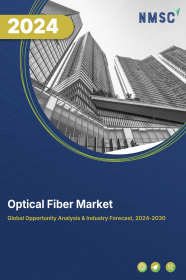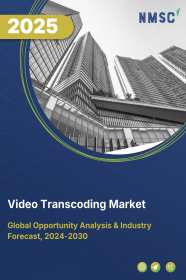
Optical Fiber Market by Mode (Single Mode, and Multi-Mode), by Cable Type (Glass Optical Fiber and Plastic Optical Fiber), by Deployment (Underground, Underwater, and Aerial), and by End User (Military & Aerospace, Oil & Gas, BFSI, Railway, Telecom, Medical, and Others)– Global Opportunity Analysis and Industry Forecast 2024-2030
Market Definition
The Optical Fiber Market size was valued at USD 7.24 billion in 2023 and is predicted to reach USD 13.07 billion by 2030 with a CAGR of 8.8% from 2024 to 2030.
Optical fiber is a communication medium that uses a thin, flexible strand of glass or plastic to transmit information using light. It has a core surrounded by a cladding layer that reflects the light back into the core, ensuring minimal signal loss. The single-mode fibre is used for long-distance transmission, while multimode fibre is used for shorter distances. Metal wires are preferred for transmission in optical fibre communication as signals travel with fewer damages and also remain unaffected by electromagnetic interference. Optical fibers are widely used in telecommunications, internet infrastructure, medical equipment, and scientific research because they are immune to electromagnetic interference and can transmit data at very high speeds over long distances. The data is transmitted by modulating a light source with the data, sending it through the fiber, and detecting the light signal at the receiving end to convert it back into the original data signal.
Market Dynamics and Trends
The increasing demand for high-bandwidth communication and data transmission services, driven by the rapidly growing digitally literate population and the increasing number of internet users, is fueling the growth of the market. According to the latest report published by the World Population Review, 69% of the global population, or 4.9 billion people, actively use the internet.
With such a significant portion of the population relying on internet services, the demand for high-bandwidth communication solutions continues to rise. Furthermore, the growing adoption of fiber-optic cables in the telecommunications sector is driving the growth of the optical fiber market due to the increasing demand for high-speed and reliable communication networks.
For instance, in December 2023, HFCL Ltd. secured an order worth around USD 8 million from an Indian telecom company, highlighting the growing investments in optical fiber infrastructure to meet the escalating demand for data transmission services.
However, the high installation cost of optical fiber and growth in the wireless communication systems are the major factors restraining the growth of the market. On the contrary, the increasing adoption of fiber to the home (FTTH) connectivity and emergence of internet of things (IoT) coupled with increasing demand for 6G internet services will create ample number of opportunities for optical fibre market in the future.
Market Segmentations and Scope of the Study
The optical fiber market is segmented on the basis of mode, cable type, deployment, end user, and region. On the basis of mode, the market is divided into single mode, and multi-mode. On the basis of cable type, the market is classified into glass optical fiber and plastic optical fiber. On the basis of deployment, the market is segmented into underground, underwater, and aerial. On the basis of end user, the market is divided into military & aerospace, oil & gas, BFSI, railway, telecom, medical, and others. Regional breakdown and analysis of each of the aforesaid segments includes regions comprising of North America, Europe, Asia-Pacific, and RoW.
Geographical Analysis
Asia Pacific is expected to hold the largest share of the optical fiber market during the forecast period. This is attributed to the factors such as increase in penetration of optical fiber technologies in developing economies such as India and China.
For instance, in February 2022, the Finance Ministry of India announced to launch nationwide BharatNet broadband network by 2025. Through this fiber network, the government aims to connect over 361,000 villages with broadband across 16 states.
In addition, in May 2022, China constructed the world’s largest mobile broadband and fiber optics network along with nearly 1.6 million 5G base stations across the country. Moreover, the rapidly increasing internet users in this region is expected to further boost the growth of optical fiber market.
For instance, the number of Indian internet users is expected to increase by 45% in the next five years to 900 million in 2025, boosting the demand for high-speed internet connectivity in this region. On the other hand, North America is expected to show a steady rise in the optical fiber market. This is attributed to the factors such as the growing investment in smart city projects in countries such as the U.S. and Canada.
As per the latest report published by the U.S. Department of Transportation, the U.S. government announced to invest in the development of smart city projects across the nation, investing USD 500 million over the next five years starting from 2024. Moreover, presence of major companies such as Adtell Integration, Adtran Inc., Cisco Systems Inc., and others play a major role in the development of optical fiber market in this region.
For instance, in June 2022, Cisco build sustainable internet for the future with advancements to its routed optical networking solution. Through this advancement, Cisco aims to reduce cost and improve internet connectivity in the North America region.
Competitive Landscape
Various market players operating in the optical fiber market include Adtell Integration, Adtran Inc., ADVA Optical Networking, Broadcom Inc., Ciena Corporation, Cisco Systems Inc., CommScope, Corning Inc., Finisar Corporation, Fujitsu Optical Components Ltd., Furukawa Electric, Huawei Technologies Co. Ltd., Jiangsu Fasten Company Ltd., Optiwave Systems Inc., Sterlite Technologies Ltd., and others. These market players are adopting various strategies such as collaboration and product launches to maintain their dominance in the optical fiber market.
For instance, in March 2024, Adtran Inc. introduced ZR and ZR+ optics with FSP 3000 M-Flex800 to eliminate the issues associated with IP-over-DWDM (IPoWDM) solutions. The optics allows network operators to fully utilize the capabilities of ZR and ZR+ optics for high-capacity transport solutions across edge, metro, and core networks.
Also, in March 2024, Broadcom Inc. introduced Bailly, the industry's first 51.2 terabits per second (Tbps) co-packaged optics (CPO) Ethernet switch. Bailly allows the optical interconnect to operate with 70% lower power consumption and achieves an 8x enhancement in silicon area efficiency compared to pluggable transceiver solutions.
Moreover, in November 2022, ADTRAN partnered with PPC to provide high-speed fiber broadband connectivity to underserved areas of Greece using ADTRAN's Total Access 5000 broadband platform. The partnership supports Greece's National Broadband Plan and aims to provide broadband service to over three million homes and businesses with fiber over the next four years.
Also, in August 2022, Adtran Inc. collaborated with TPG Telecom Group to upgrade existing broadband services to gigabit broadband services using Adtran’s second generation gigabit Gfast fiber extension in Australia.
Key Benefits
-
The report provides quantitative analysis and estimations of the optical fiber market from 2024 to 2030, which assists in identifying the prevailing market opportunities.
-
The study comprises a deep-dive analysis of the optical fiber market including the current and future trends to depict prevalent investment pockets in the market.
-
Information related to key drivers, restraints, and opportunities and their impact on the optical fiber market is provided in the report.
-
Competitive analysis of the players, along with their market share is provided in the report.
-
SWOT analysis and Porters Five Forces model is elaborated in the study.
-
Value chain analysis in the market study provides a clear picture of roles of stakeholders.
Key Market Segments
By Mode
-
Single Mode
-
Multi-Mode
By Cable Type
-
Glass Optical Fiber
-
Plastic Optical Fiber
By Deployment
-
Underground
-
Underwater
-
Aerial
By End User
-
Military & Aerospace
-
Oil & Gas
-
BFSI
-
Railway
-
Telecom
-
Medical
-
Others
By Region
-
North America
-
The U.S.
-
Canada
-
Mexico
-
-
Europe
-
The U.K.
-
Germany
-
France
-
Italy
-
Spain
-
Denmark
-
Netherlands
-
Finland
-
Sweden
-
Norway
-
Russia
-
Rest of Europe
-
-
Asia-Pacific
-
China
-
Japan
-
India
-
South Korea
-
Australia
-
Indonesia
-
Singapore
-
Taiwan
-
Thailand
-
Rest of Asia-Pacific
-
-
Rest of the World (RoW)
-
Latin America
-
Middle East
-
Africa
-
REPORT SCOPE AND SEGMENTATION:
|
Parameters |
Details |
|
Market Size in 2023 |
USD 7.24 billion |
|
Revenue Forecast in 2030 |
USD 13.07 billion |
|
Growth Rate |
CAGR of 8.8% 2024 to 2030 |
|
Analysis Period |
2023–2030 |
|
Base Year Considered |
2023 |
|
Forecast Period |
2024–2030 |
|
Market Size Estimation |
Billion (USD) |
|
Growth Factors |
|
|
Countries Covered |
28 |
|
Companies Profiled |
15 |
|
Market Share |
Available for 10 companies |
|
Customization Scope |
Free customization (equivalent to up to 80 working hours of analysts) after purchase. Addition or alteration to country, regional, and segment scope. |
|
Pricing and Purchase Options |
Avail customized purchase options to meet your exact research needs. |
KEY PLAYERS
-
Adtell Integration
-
Adtran Inc.
-
ADVA Optical Networking
-
Broadcom Inc.
-
Ciena Corporation
-
Cisco Systems Inc.
-
CommScope
-
Corning Inc.
-
Finisar Corporation
-
Fujitsu Optical Components Ltd.
-
Furukawa Electric
-
Huawei Technologies Co. Ltd.
-
Jiangsu Fasten Company Ltd.
-
Optiwave Systems Inc.
-
Sterlite Technologies Ltd.




















 Speak to Our Analyst
Speak to Our Analyst
























